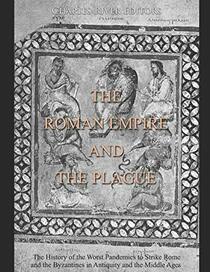This book outlines the plagues that harassed the Roman and Byzantine Empires in antiquity.
The Antonine Plague - 165 - 180 CE
The pandemic of 165 CE was brought home by Roman soldiers fighting in countries with unknown diseases. When they returned from these conquests, they got the infection to infect their loved ones and fellow citizens. Estimates claim that more than five million people perished. Scientists think this pandemic was smallpox, and it lasted 15 years. It accounted for the growing instability of the Roman Empire. At its height, 2000 Romans died each day. During this time, barbarian groups started to attack the Roman Empire, and the Romans lacked sufficient troops to fight against the hordes.
The Plague of Cyprian - 250 - 271 CE
Named after St. Cyprian, a bishop of Carthage described the epidemic as signaling the end of the world. Estimates are that 5000 people died in Rome each day. Thought to be either smallpox or measles, it decimated the city of Rome.
Plague of Justinian - 540 - 541 CE
Bubonic Plague ravaged the Byzantine Empire, which marked the start of its decline. The plague was named after Byzantine Emperor Justinian (emperor from 527 - 565 CE). Amazingly, Justinian was struck with the plague but somehow survived. Estimates are that 10% of the world's population died from this plague. The plague reoccurred periodically afterward.
The Roman Plague of 590 CE
Before the plague came, many of Rome's granaries were damaged when the Tiber River flooded in the fall of 589. Probably the bubonic plague, historian Gregory of Tours described it as a disease of the groin. The Bishop of Rome, Pelagius II, died of the plague in February 590.
Finally
At its apex, Rome was 1.5 million strong (around 160 CE). By the end of the plagues, Rome was a town of 35,000. Its trade routes were gone, the countryside was barren, and no workers remained to till the fields.
The Antonine Plague - 165 - 180 CE
The pandemic of 165 CE was brought home by Roman soldiers fighting in countries with unknown diseases. When they returned from these conquests, they got the infection to infect their loved ones and fellow citizens. Estimates claim that more than five million people perished. Scientists think this pandemic was smallpox, and it lasted 15 years. It accounted for the growing instability of the Roman Empire. At its height, 2000 Romans died each day. During this time, barbarian groups started to attack the Roman Empire, and the Romans lacked sufficient troops to fight against the hordes.
The Plague of Cyprian - 250 - 271 CE
Named after St. Cyprian, a bishop of Carthage described the epidemic as signaling the end of the world. Estimates are that 5000 people died in Rome each day. Thought to be either smallpox or measles, it decimated the city of Rome.
Plague of Justinian - 540 - 541 CE
Bubonic Plague ravaged the Byzantine Empire, which marked the start of its decline. The plague was named after Byzantine Emperor Justinian (emperor from 527 - 565 CE). Amazingly, Justinian was struck with the plague but somehow survived. Estimates are that 10% of the world's population died from this plague. The plague reoccurred periodically afterward.
The Roman Plague of 590 CE
Before the plague came, many of Rome's granaries were damaged when the Tiber River flooded in the fall of 589. Probably the bubonic plague, historian Gregory of Tours described it as a disease of the groin. The Bishop of Rome, Pelagius II, died of the plague in February 590.
Finally
At its apex, Rome was 1.5 million strong (around 160 CE). By the end of the plagues, Rome was a town of 35,000. Its trade routes were gone, the countryside was barren, and no workers remained to till the fields.




